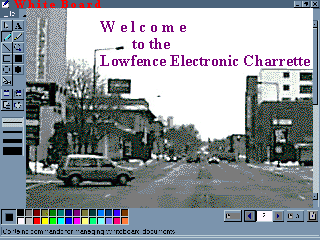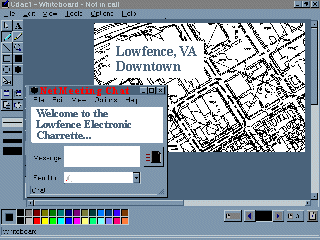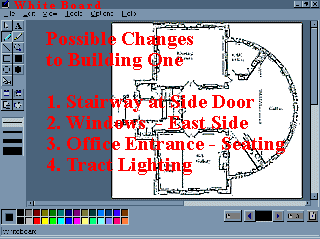|
|
|
collaboration | access | virtuality | sustainability
Historic Renovation / Community
Planning and Design Center Project
CDAC Application #203 - Lowfence, Virginia June 1999
White Paper #1 -
Author: william george paul

NetMeeting White Board Screen:
Kick-off of the Lowfence Electronic Charrette!
Lowfence, Virginia is a small (population 8,045) coastal town with many run-down historic
buildings and a small but future looking city planning department. After detailing a
project and budgetary resources, Lowfence submitted their CDAC Online Application in June
of 1999 and received acceptance from the Advisory Board in September. Because CDAC is able
to service clients through their web site and electronic community building and design
processes, much of the preliminary community organizing, data collection and Q&A were
facilitated through e-mail exchanges and asynchronous updates of the Lowfence Project Web
Site (LPWS), which was sited on the LAR server at Virginia Tech:
http:www.lar.arch.vt.edu/ program/LPWS/welcome.html
It is important to note that the client had direct access to the VT server for web site
updates and that the local library served as an access site for the townspeople who where
not yet online.
The Project Background and Scope
The Historical Renovation / Community Planning and Design Center Project was selected by
the Advisory Committee on the basis that it offered students and faculty work experience
in both Information Technology and historic preservation and community building; because
of the highly design or conceptual nature of the process; and because it fit closely with
the distance learning mandate from the original CDAC Online charter (developed as a
companion strategy with the original CDAC process after the ASPIRES grant was awarded to
the Center in January 1998). After successes with the Culpeper County Bike Ways Charrette
in 1998 and the Jefferson City Mall Laboratory Project in February 1999, the CDAC Online
staff had made the necessary campus connections to accomplish online workshops, dynamic
web sites and electronic charrettes. Partnerships were forged with technologists and labs
in the Education, Distance Learning and VT Media Production departments.
The three main components of the Lowfence proposal included:
1. Analysis, selection, and renovation of a downtown building to house the new Design
Center.
2. Analysis, design and installation of a high tech, community design facility that would
include new PC's, a server and other hardware and software items.
3. A final report that would serve as an information technology master plan for the town.

NetMeeting Chat Screen with City Map
The CDAC Online Project Process in Lowfence
For simplification, the game plan for meeting the three goals of the Lowfence project are
listed in chronological order:
September 1999:
Project leaders meet for the first (of two total) face-to-face meetings at the
Distance Learning Lab in McBryde Hall. Data is delivered by the town for the first stage
of the LPWS, as are building plans, site plans, planning ordinances, preference survey and
graphics. A complete review of the online tools and processes were covered and the
Lowfence group taped the session for use as a training tool back home.
The first version of the LPWS went online with the following features and tools: return
e-mail addresses, web site links, project scope and data from the earlier meeting. All
online workshop schedules and deadlines were set-up as "tentative" pending
confirmation from both CDAC Online staffers and project participants.
November 1999:
Online Workshop #1 - CDAC Online and Project Coordinators Only. Project leaders finalized
project goals, deadlines and meeting schedules. Preparation for the electronic charrette
included targeting all CAD images, photographs, text and resources. Task assignments made.
A committee was formed to write the first draft of the IT master plan.
December 1999:
The Electronic Charrette -
Historical Renovation / Community Planning and Design Center Project
Lowfence Community Members & City Hall Staff, CDAC Online Project Members and Invited
Experts
Program Component:
Agenda + Base Images
Video Conferencing
White Board + Chat
Moderator
Experts (Pre-arranged)
Press
|
Tools / Process Employed:
LPWS
SeeYou - See Me
NetMeeting
CDAC Online Project Leader
Specific to preservation and IT issues
VT Campus, local and State newspapers / radio
|
The electronic charrette (EC) brought together all of the
above participants in a give and take (1-1/2) hour session that discussed electronic
imagery of the final building sites, floor plans, hardware and software specifications and
the draft IT master plan. All participants made comments and added graphical changes to
the shared photographs and plan elements. Participating experts were Robert Springtree, a
noted architect and preservationist from Salisbury, England, and Alice Humphrey-Rice, an
educational technology and Internet consultant from Washington, D.C. Recommendations,
charrette scripts and final ec images from the event were added to the LPWS the next day
in preparation for the pending solution set from CDAC.

NetMeeting White Board with Building Floor Plan
January 2000:
Presentation to the Community - Lowfence City Hall. Together with their clients, press and
community leaders, CDAC Online staff presented their solutions to the Lowfence community
on January 21st. Because sustainability was stressed throughout the process, the solutions
reflected a long term cost / benefit strategy that included:
1. A complete building renovation was recommended for a 1912 storefront-- from the brick
exterior to the telephone jacks in each room. Space was included for a classroom, a small
office and large work / computer area. A rear deck was also included for an alternative
meeting space.
2. Center computers and software were initially donated from area schools and then
supplemented with new machines with a grant from a local private supplier. The LPWS
continued to be a source of project assistance and communication with the outside.
3. The Lowfence IT master plan was later adopted by the City Council and is being
implemented. Partnerships with the private sector continue to be a key strategy for the
town's technology scheme.
Conclusion Points
- Involvement and Access: Through their schools and home machines, a 67% online total
participation rate was achieved by the CDAC Online process!
- Web Site Archive: As a continuing place for debate, archiving and communication, the
LPWS continues to be a part of the town's planning and design plan.
- Cost Savings: Because face-to-face meetings were cut (at least) in half, funds were
utilized for more publicity, software and expert time.
- Experts: Outside assistance can be deployed at no travel cost and with great
specificity.
- Collaborative Research: VT research and international efforts can be combined in this
process.
- CAD images (i.e.- electronic image formats): ease of updates, file sharing via the
Internet.
- Web Site is constructed in stages, each updated as the project progresses and culminates
in a case study.
- Both synchronous and asynchronous communication is possible.
Back to Paper

|